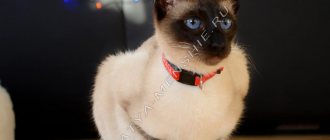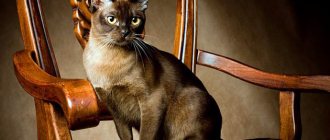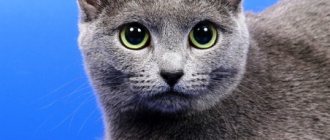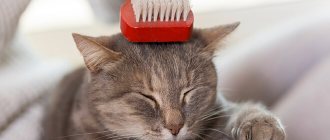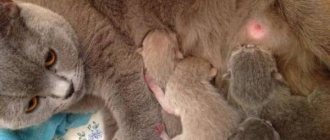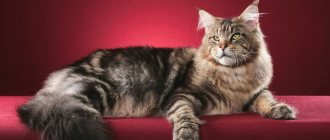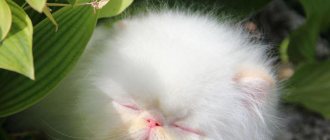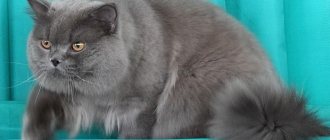In the last century, breeders set out to create a cat similar to their forest counterparts. They wanted to get a pet with the same color, but with a softer and more flexible character. This is how Bengals appeared, which are also called miniature leopards. This breed has a different temperament than other domestic cats. Anyone who decides to buy such a friend needs to know how to care for a Bengal kitten and raise it correctly.
How to care for a Bengal kitten?
Bengal cat standards
Genetics links the breed to the Asian leopard
The breed originates from the United States of America. A wild Bengal kitten rescued from poachers ended up in the hands of a breeder. Over the decades it has been crossed with various pets. Thus a new stable breed emerged. Since the late 90s she has taken part in various exhibitions.
Table 1. Bengal cat according to TICA
| Part of the body | Indicators |
| Weight | 4–8 kg |
| Body | Muscular, oblong, medium to large in size. The limbs are medium-long, the front pair is slightly shorter. The paws are clenched into round fists. The tail is also of medium length, quite thick, slightly tapering and rounded at the end. The skeleton is strong, devoid of subtlety. |
| Head | Wide wedge-shaped, rounded, the greater the difference with domestic breeds, the better. The jaw area is massive. |
| Ears | Small in height, wide at the bottom, rounded at the tips. The presence of tassels is not recommended. |
| Eyes | Oval, almost round, large, but not too big. Set wide and slightly oblique. The color of the iris is more welcome, and it does not depend on color (not counting links points). |
| Nose | Wide, large. The lobe is slightly upturned. The forehead meets the nose without a pronounced bend. The bridge of the nose is located just above the eye sockets. |
| Muzzle | Wide, the whisker pads stand out and have a slight pinch at the transition to the muzzle. The cheekbones are high and expressive. |
| Coat | The length of the hairs is short or medium, in kittens it is a little longer. It looks rich and shines (glitter effect), believed to be due to the voids in each fiber. The hairs lie tightly to the body. |
It is sometimes claimed that Bengal cats are hypoallergenic. But this is not entirely true. In fact, they simply shed less than many other breeds.
Less fur makes it easier for people to tolerate the presence of these cats in the house.
Bengal cat in all its glory
Color
The coat color of high-quality Bengals is contrasting and bright. The belly is lighter in color, with noticeable spots.
The final color is acquired only by 16 months. The photo shows a Bengal cat with a brown tabby kitten
The color of the head, typical of a tabby, is important. The eye sockets, the nasal mirror should be outlined, there should be a letter M on the forehead, and dark stripes on the cheeks. According to the standard, contrasting rings or rosettes are placed on the tail, and the limbs are “decorated” with bracelets. One of the most important requirements for coloring is the horizontal placement of spots and stripes, while usually it is vertical.
Absence of spots on the belly is considered a serious defect
The patterns characteristic of the breed are spots and stripes. The spots can be of any design - for example, bagels, but with clear edges. They must be formed by two or more colors. Marble colors, which are formed from intertwining color ribbons, are also recognized as standards.
There are two types of tabby colors recognized: brown and silver. But there are also snow bengals, which are divided into colorpoint, sepia, and mink. Blue cats are also considered standard; their fur is silver; the contrast here is somewhat less pronounced.
Bengal cat tabby color - silver
There should be a letter M on the forehead
How the breed appeared
And it all started with a secret love. The black cat fell under the spell of the attractive eyes of a cat belonging to the Asian leopard breed (Filesbengalensis). The cat lived in Arizona, in the house of owner Jean Sardin. Jean bought it at a pet store. Later, the owner noticed that the black cat was not indifferent to this graceful creature, she did not interfere with their love. A few months later, the couple gave birth to a spotted cat, which Jean mated with the same cat. In numerous hatches, some kittens turned out to be spotted, and some of them were multi-colored.
The year was 1963. By that time, Jean's husband had died and she was engaged in breeding. But apparently the Bengal was still destined to be born, because soon after, on the other side of the country in California, Dr. Willard Centervall began research on Filisbengalensis. In the early 70s, this American geneticist, a researcher at the University of California, decided to reveal the secret of the Filisbeng, since it was believed that this breed had a natural immunity to leukemia.
He contacted Jeanne Mill and provided her with eight first-generation hybrid females. Thus, the Millwood Bengal cattery was founded. The Asian forest leopard carried antibodies to leukemia. The geneticist approached this issue thoroughly and, having carefully studied it, acquired the desire to reveal this secret. He managed to completely domesticate a small domestic leopard.
Bengal behavior
Character depends on the level of development and generation. Generations no lower than F4 are recommended for home keeping. These are softer, more flexible animals than their predecessors.
A kitten is not considered a real Bengal if its generation is below the fourth. It should also be noted that in the first three generations there are many sterile males.
Bengal cats are often compared to dogs due to their characteristic habits. Moreover, they easily get along with this type of animal and even love the same toys and fun, and love walks. Bengals are easy to train. Another characteristic “dog” trait is that Bengals choose one owner, to whom they are devoted under any circumstances.
Bengals are walked on a leash like dogs.
Despite their “predatory” origin, they find joy in communicating with other inhabitants of the house, except for rodents and small birds. By the way, they love to hunt for the latter and are successful in this.
These cats attract the owner's attention in an interesting way by hiding his things. They steal anything - from jewelry to paper bills. The priority is children's toys, stationery, and hair care accessories. From their wild ancestors, Bengals still have a love of water treatments. You cannot give them access to the aquarium, since we are talking about natural fishermen. Bengals love human company. They often watch their owner for a long time - for example, when he is taking a bath, and when the mood strikes, they keep him company.
Bengal kittens love to splash in the water
Mini-leopards are very active, they explore every corner of the house, and when the opportunity arises, they climb into every crevice. They need attention and love to play. They always need more and more new toys, and of an intellectual direction.
Representatives of the breed are real climbers. This quality was passed on to them from their ancestors. When taking such a pet, you need to take care of reliable protection against falls from a height, especially in high-rise buildings.
Bengals bite everything that gets in their way, including their owners and furniture. To satisfy this instinct, special toys will be required, otherwise not only the furniture is at risk, but also the skin of the inhabitants of the house.
Claw pads for cats
This is one of the most "talkative" breeds. With their voice they express their needs and desires. The range of sounds they produce is quite wide - from growls to gentle meows. And their purring can be heard even from the next room.
Video - How a Bengal cat “talks”
Conclusions about the breed
The Bengal cat deservedly receives praise and admiration, but not only due to its chic external characteristics:
- The cat's character is ideal for sociable and sensitive people. Both adults and children can play with the furry baby;
- if the owner does not have time to care for the cat, then it is better to opt for a less demanding breed;
- without experience it is not worth breeding cats;
- a well-developed intellect only pleases;
- the cat does not like to be squeezed;
In general, Bengals have good health and delight with their intelligence.
Feeding a Bengal cat
Feeding this type of cat often causes difficulties due to the sensitivity of the digestive system, which is a feature of the breed.
Economy class products are contraindicated for Bengal cats. Such food worsens the health of the animal. Another feature of the breed is that its representatives have difficulty with changing food.
Bengal cat at lunch
Kitty
Young individuals under the age of 9 months are especially sensitive to nutrition. For the first month of life, the baby should eat only mother's milk, with which temporary immunity is transmitted to him. If a kitten at this age was separated from its mother for some reason, then special suspensions will be the best choice for it. Cow's milk should not be given, it is too heavy food. Feeding is carried out at least 6 times a day.
The best food is mother's milk
At 8 weeks, complementary foods are introduced in addition to milk, which should still make up at least half of the diet. The frequency of feedings is reduced to 6 times a day. The following products are acceptable:
- meat - boiled (preferably) or raw, pre-frozen for at least two days;
- liquid porridge from rice, oatmeal, semolina with the addition of meat in a ratio of 1 to 1;
- low-fat fermented milk products.
It is allowed to include soft pates in the diet. “Children’s” lines are offered by Royal Canin, Pro Plan. Crackers are not allowed at this age. As a last resort, they are offered soaked in water.
Royal Canin pate for kittens
By the fourth month of life, kittens completely refuse breast milk, the fermented milk group is reduced to 20%. Meat products should make up 60% of the diet. The rest is porridge and boiled vegetables (raw carrots, asparagus, cauliflower).
Bengal kitten eating
Adult cats
The feeding frequency for healthy adults is 2 times a day. If preference is given to dry food, then it should be products from the premium and super-premium segment. These are brands such as:
WildCat food line for cats
Carnilove line of food for cats
Orijen dry food
In the diet of an adult cat, lean meat should account for at least 70%. If the product is given raw, it is first frozen to destroy the parasite larvae. The meat is offered cut into pieces.
The main food of Bengals is lean meat.
The menu also includes:
- offal;
- chicken necks, especially during the period of teeth change;
- frozen fish fillet (once every 2–4 weeks);
- raw quail eggs (once every 7 days);
- vegetables - pumpkin, zucchini, carrots, spinach;
- cereals - buckwheat, rice, egg in the form of porridge, as well as sprouted wheat grains;
- cottage cheese 0% fat.
Bengal cats prefer fresh food
What you should absolutely not do
If the owner wants to train a cat to sit in his arms, he needs to know not only what measures will help to do this, but also what not to do. Absolutely forbidden:
Breed characteristics.
Representatives of some breeds cannot stand people's hands or touching them at all. Siberian belongs to this category.
The breed is wayward, cats are reluctant to make contact with people, especially not like to sit in their arms. Sometimes they have a surge of tenderness for people, and they voluntarily go to their knees. Therefore, any attempts to force or try to accustom Siberians to hands will never be crowned with success.
It is not difficult to tame a cat. The main thing is to be patient. If everything is done correctly and consistently, gradually establishing contact, sooner or later any cat will get used to sitting on the owner’s lap. If no measures help, perhaps it’s all about the character of the animal, which simply does not like to be touched. In this case, you should give up trying, because they will be in vain. Perhaps, occasionally, the cat itself will decide to show sympathy for the owner, sometimes jumping into his arms.
Source
Bengal care
You need to prepare for the arrival of a Bengal kitten. The standard set of items includes:
- tray - preferably with high sides so that the contents do not fall outside the container;
- filler - the one to which the animal is already accustomed;
- utensils for eating and drinking - ceramic or metal are better, since microcracks in aging plastic can harbor microbes;
- a do-it-yourself pet bed or house (these cats are territorial and need their own shelter);
- a play complex with playgrounds almost under the ceiling, since Bengals love heights;
- several toys - balls, tunnels, laces, bells, etc., there are never too many of them.
House for a Bengal cat
How to cheer up a cat if he's bored? You can read more about ways to determine the cause of such a mood and techniques that will help improve your pet’s mood in the article “How to Cheer a Cat” on our website. In addition, you will receive recommendations on the use of modern gaming gadgets in your cat’s daily life, and you will also be able to decide on the choice of toys and treats for your bored pet.
Bengals are distinguished by exceptional cleanliness. Therefore, the tray should always be clean. If the used filler is not removed in time, the owner may be in for an unpleasant surprise - a puddle in the wrong place.
To prevent the wool from losing its magical shine, it is cared for accordingly. Weekly brushing is a must. The brush removes dead hair and helps distribute sebum evenly over the entire surface of the body.
A cramped apartment is not suitable for a Bengal. This is an active cat that needs ample space to play, run, and climb. It's good if you have access to the street.
Running wheel for cats - additional physical activity
In the material “Running Wheel for Cats” on our website you will find out the benefits of a running wheel for a cat. How to get her used to the running wheel. In addition, the article talks about what types of running wheels there are, what design to choose in the store, and also how to make a running wheel for a cat with your own hands.
To keep your teeth healthy, cleaning with special brushes and toothpastes is necessary. If the animal resists, sometimes instead of the procedure they offer to chew dry jerky.
Many Bengals, despite their craving for cleanliness, bathe in toilets. Therefore, this piece of plumbing must always be covered with a lid.
Hygiene
Bengals have short hair, but if you feed them well, it will be smooth, thick, and shiny. There will be no problems caring for this coat. Basically, the animal will cope on its own. If you want, sometimes run a special brush over your pet’s back and neck, it will be pleasant and useful for him. It is not necessary to wash if there is no visible dirt.
But trimming the nails won’t hurt, but it should be done at the very tips with a special nail clipper. Once a week is fine. This does not mean that animals then do not need a scratching post; they sharpen their trimmed claws with pleasure.
The ears can be wiped with a swab in case of visible contamination.
Training and education of a Bengal cat
Everything fragile and valuable is removed from accessible places. Any thing that comes under the paws turns into fun. Therefore, the kitten is provided with an arsenal of toys. Animals prefer everything that rustles and buzzes.
Bengal needs his owner to play with him. Suitable fun is hide and seek around the corner. You need to talk to the cat. In communication, commands are used that correct the pet’s action - the words “no”, “fu” or “well done” if the cat did well, etc. First, in order to remember, the spoken word is accompanied by some action - for example, a pinch on the neck.
Violence is not applicable to cats. The exception is when it is necessary to urgently hold an animal or undergo a medical procedure. Screaming and swearing are unacceptable.
You can't hit a cat
If a cat plays with a prohibited object, it is stopped with a verbal prohibition or a loud clap: animals associate sharp sounds with danger. Use a water gun effectively.
Bengals are touchy and have a good memory. Even a one-time undeserved punishment will cause them to distrust their owner. Then it is difficult to establish contact.
Bengal cats have developed intelligence compared to other breeds. They easily learn the commands that dogs perform - for example, “Give me your paw.” You can learn training skills at special courses, which are often organized by felinological communities.
Bengal cat training
Tricks that the animal can master:
- bring an abandoned stick to the owner;
- jump from chair to chair like a tiger in a circus;
- walk on a pole;
- walking between the owner's legs when he takes a step;
- dance on hind legs.
A kitten is taught to use a leash from 3 months
Animal health
Domestic Bengal cats are prone to certain diseases. They have problems with the gastrointestinal tract, which may cause periodic diarrhea. Heart diseases, such as hypertrophic cardiomyopathy, also occur. Kittens sometimes develop flat chest syndrome. Bengals have a tendency to allergic reactions and weakened immunity.
It is necessary to carry out regular prevention of cat diseases, adhering to the following rules:
If you choose a high-quality diet for your mustache, then gastrointestinal diseases will not affect it.
- Given the predisposition to gastrointestinal diseases, you need to choose the right diet for your pet. Everything should be fresh, high quality, safe for the stomach and intestines.
- Carry out vaccination and deworming according to schedule.
- Take your cat to the veterinarian every year to prevent health problems or increase them in time.
- It is necessary to treat for fleas and ticks.
- If mating and breeding of animals is not planned, it is necessary to carry out sterilization (castration).
How much does a Bengal cat cost and where can I buy it?
This breed is among the top 10 most expensive. The cost of a kitten is from 10 thousand rubles. It is better to buy a Bengal cat in nurseries, where they will provide a pedigree and other documents for the animal.
This breed is not for everyone
Although Bengals are a rather expensive breed, you can save money. For example, individuals with defects that are not recognized by the standard are cheaper, but this does not affect the appearance. Kittens in adolescence (from 4 to 6 months) also cost less. Sometimes individuals are taken out of breeding, which also makes it possible to become the owner of a Bengal for relatively little money.
History of the breed
The continuation of the Far Eastern cat family happened thanks to the American biologist and geneticist Jean Mill. She literally saved this species from extinction.
Advertising:
While on a business trip to Bangkok in 1961, Mill noticed Bengal kittens at the market. They were sold as souvenirs, and older cats were destroyed for their valuable fur, which was very similar to a leopard coat.
The biologist was very inspired by the difficult fate of these defenseless individuals, which is why she decided to buy herself a Bengal cat. An experienced breeder decided not to waste the opportunity and try to create a new breed with the appearance of a wild Bengal and the character of a domestic animal.
Arriving home, Mill actively began breeding a new species and crossed a wild cat with a simple domestic cat. The first attempt was unsuccessful. The kitten inherited the external characteristics of its mother, as well as her wild character. But the biologist did not give up and turned to American scientists she knew for help. The final solution was to cross the Bengal with the Egyptian Mau and the Burmese cat.
Conditions of keeping: how to arrange a comfortable stay for a Bengal cat in the house
Household items that are truly vital for Bengal cats include:
- separate bowls for food and water;
- a lounger-bedding or a box - a house, you can use a spacious basket;
- a toilet in the form of an open tray or a closed structure, with filler in it (it happens that a cat does not go to the tray, preferring the toilet);
- toys in a wide range of sets - sticks, balls, artificial rodents, a running wheel, ideally a play complex is desirable, various houses - Bengals have an increased need for active games;
- scratching posts preferably of two types - with hard and soft structures (wood, cork, rope, bark).
Also, from time to time a special carrying box or bag for transportation is required.
Special devices
Scratching posts help save the decor and interior of the house from the claws of domestic predators. Even if the pet is walking outside, in the apartment he will sharpen his claws several times a day. When choosing an accessory, pay attention to:
— stability, structural strength;
— quality of materials, functionality;
— a height sufficient for an adult animal: a Bengal cat actively stretches its body to grasp with its claws.
Since Bengal cats like to scratch surfaces at different angles, it is more rational to install several scratching posts - vertical (this one can have a resting area at the top), wall-mounted, horizontal.
What types of harnesses and collars are there?
Collars are purchased for different purposes - therapeutic and prophylactic and for walking, decorative for aesthetic purposes, and informational - so that a lost animal finds its home again. Nowadays special harnesses are produced for walking.
Walking harnesses are leashes of a special design that are preferable to a collar due to their safety for the animal. The cat's neck will not slip out of such a leash, and the danger of getting caught on anything is eliminated. Various designs distribute the load and do not put pressure on the pet's throat. Walking harnesses are:
— V-shaped, when the connecting bar of the loops falls on the cat’s chest;
- H-shaped, in which the bar rests on the back;
- in the form of two loops connected by a figure eight;
- in the form of a vest - such designs also allow you to protect the cat’s fur coat from dust, precipitation and dirt in some places.
Owners can choose soft leather, light cotton, durable, practical nylon harnesses.
Do they shed
Shedding is a natural occurrence, but Bengals shed less than normal kittens. If your pet has been shedding for a long time, you should contact your veterinarian or review your kitten’s diet.
With proper care, the owner may not even notice how the molting occurs. Why does shedding happen and when should you worry? Seasonal shedding is normal.
In addition, cats' hair may fall out after childbirth, after suffering stress, or as a result of feeding low-quality food.
An incorrect diet dries out your pet’s skin, and it does not receive the required amount of vitamins and minerals. The appearance of the coat is an indicator of the health of the animal.
Photo: cozy place to relax
Safety
Kittens love heights, so you should carefully monitor them. Don't leave windows open unattended if you live in a high-rise building. Also make a safe place to climb onto a cabinet or refrigerator (install shelves against the wall). Also, hide any wires in the house that the kitten has access to.
Do all the preventive measures and vaccinations on time, then your Bengal will be healthy and beautiful! See also rare and beautiful names for boys cats.
